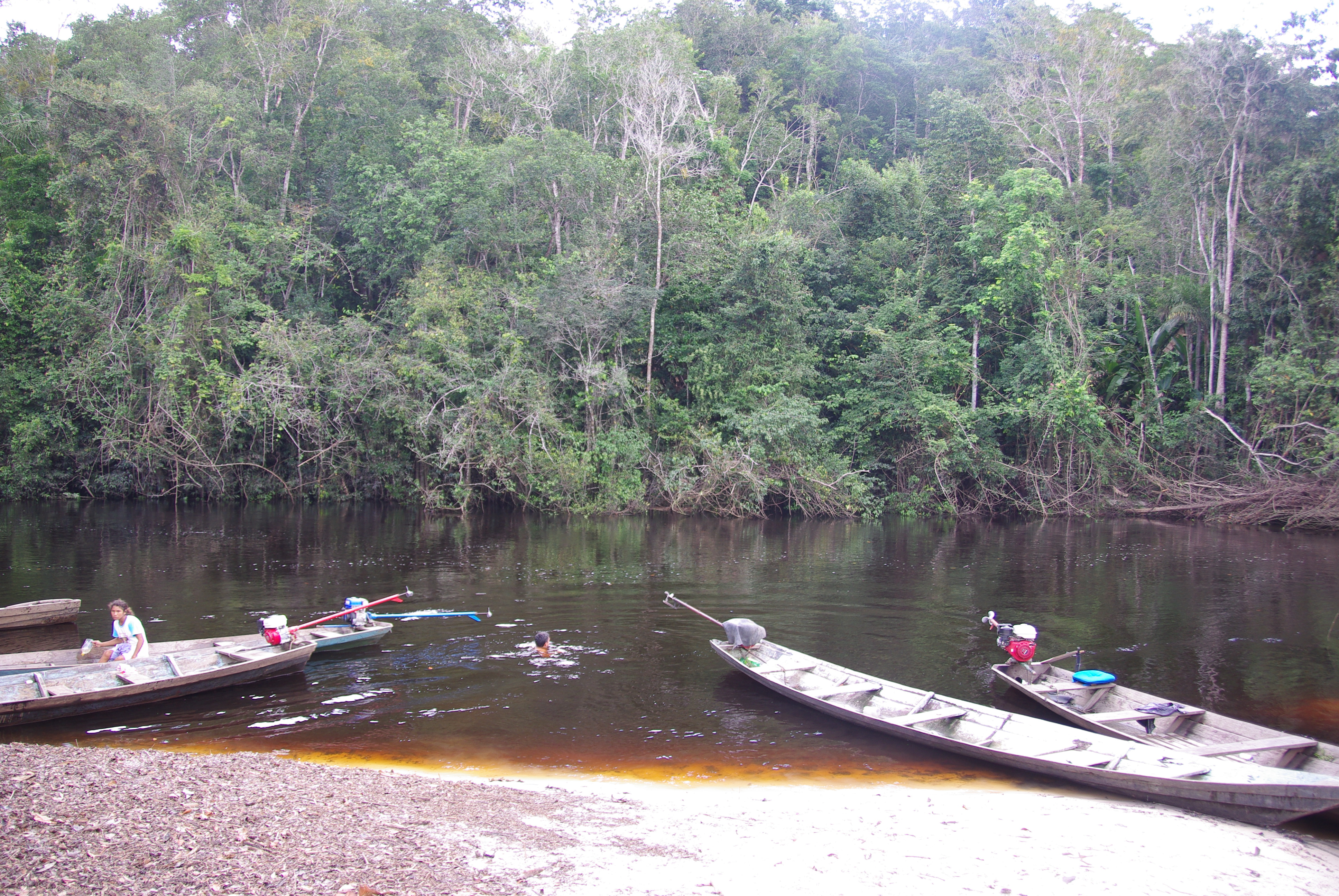
Last night I had the occasion to meet a friend I had come to know through Instagram thanks to our mutual love for travel and photography. This friend asked me to tell my “Top 5 travel stories,” which, along with requests for my “Top five (or ten) travel destinations,” is one of the most common questions I get asked. I am sure many of you have been asked something similar in your experiences; these aren’t easy questions to answer. Nonetheless, I will give it a shot in a series of my top ten travel stories to date.
One story that I get asked to repeat a lot, however, is my story about my time in the heart of the Amazon in Brazil. The subtitle for this story is really “Why you shouldn’t go to the Amazon and go to the Pantanal instead.” And my story, I feel, makes a compelling case for this argument, but it’s a little long so you’ll have to bear with me!
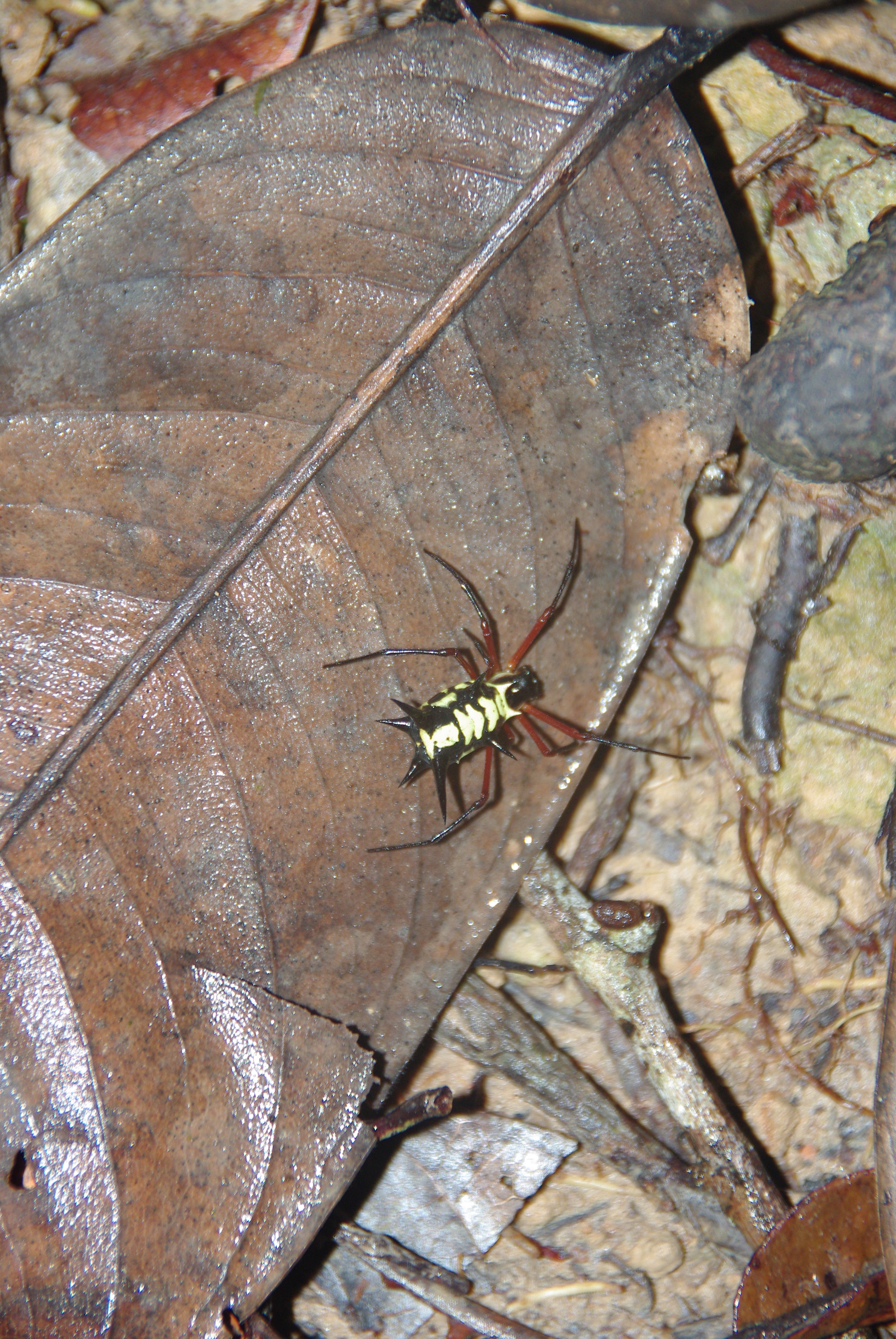
The Amazon, easily the world’s most famous rainforest, conjures images of adventure, romance, and danger, as well as visions of wild animals such as pink dolphins, jaguars, piranhas, and monkeys. The reality of the place is far different from the romanticized narratives we may have floating in our heads. The Pantanal, the world’s biggest swamp land (nearly the size of France), with its more open expanses and waterways, is the place to go to view “jungle wildlife.” The Amazon at its heart is a complex biosphere of intermingled life, extremely difficult to unlock and unravel during a short visit. Most of the wildlife you see here is the micro kind: wedged into rotten tree bark and under wet leaves; you only see the larger animals at great distances: in the canopy 200 feet above you or on the riverbank across from you. And the conditions are nearly unbearable at times.
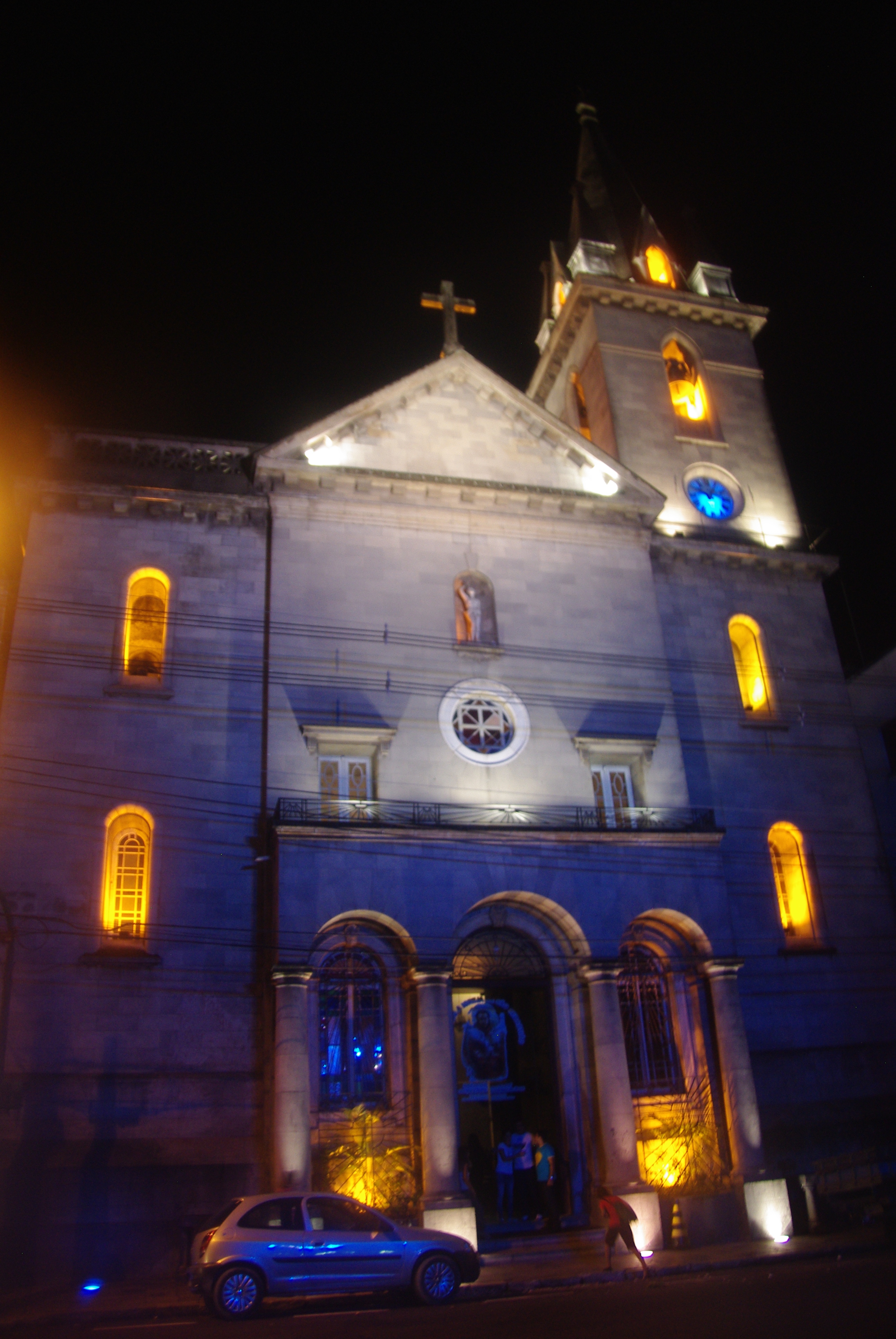
My story begins, as most Brazilian Amazon stories do, in the city of Manaus, likely known to you now as the city with the most crippling heat and humidity conditions for the recent World Cup. Most tourism ends here: boats take you to the “Meeting of the Waters,” where two distinct flows of water meet, but don’t mix and instead run side by side. Amazon: box ticked. Never one to be satisfied with the “standard” experience, I wanted the full jungle excursion. So, following Frommer’s recommendation, I signed up with Amazon Mystery Tours: http://www.amazon-outdoor.com for a 3 night kayaking excursion on the Urubu River, a tributary of the Rio Negro. I was to join a couple from Florida who had already booked a trip.
The day of departure, I left my suitcase at my inn in Manaus, put my gear in a dry bag the tour company provided for me, and headed out of town in a VW van with my guide and my cook; we had a three hour drive ahead of us to a place called Presidente Figueiredo. The Florida couple had been delayed in transit from Iguazu Falls, so it was just me at this time. Along the way, we were stopped by a lone national police officer who had set up a checkpoint on the side of the road. The law in Brazil states that foreigners must carry with them their passport with valid visa at all times–not a copy, but the original. Most of the time, they are satisfied with copies unless you’ve done something wrong, but not this guy. Of course, knowing I was going kayaking in the jungle for three days, I had left my actual passport in my locked luggage back at my inn in Manaus. The officer threatened to detain me. My guide, Rinaldo, pleaded on my behalf to have me allowed to be free, on the condition I go back to get my passport. So, we had to turn around and drive back for two hours to go get my passport. My trip was off to a great start! When we returned to the checkpoint, of course the officer was nowhere to be seen.

After this initial hiccup, Day One was relatively tame. We got to our destination, had a lunch of fresh grilled river fish tambaqui, which I got to know quite well during my trip. And then the skies opened up and it rained for about a half hour. When the rain stopped, the humidity level went up about 3 notches. The place was a veritable steam room by the time we set off in our kayaks in the late afternoon. After paddling downstream for a while, I noted that there was so little wildlife to be seen. The Urubu River was a dark brown hue and opaque, so fish weren’t visible. The birds that would fly by would fly over the tops of the trees, so they were quite some height away from us in our kayaks, and the only mammalian wildlife we saw was a family of river otters who were so cautious about our approach, we only saw them at a distance of about 100m before they dove away to hide.
At this point we were losing the light quickly, so we found a place to pull our kayaks in and set off on foot on a loosely-trampled/defined “trail” the tour company uses to get to our camping spot for the night. “Camping” itself is a loose term for our sleeping arrangements, which consisted of a tarp strung among some trees to provide a roof against the rain, and hammocks hung underneath. A mosquito net was optional, where the trade-off in protection from critters was weighed against the additional heat that the netting brings. Rinaldo opted for no netting; I, of course, bought in.
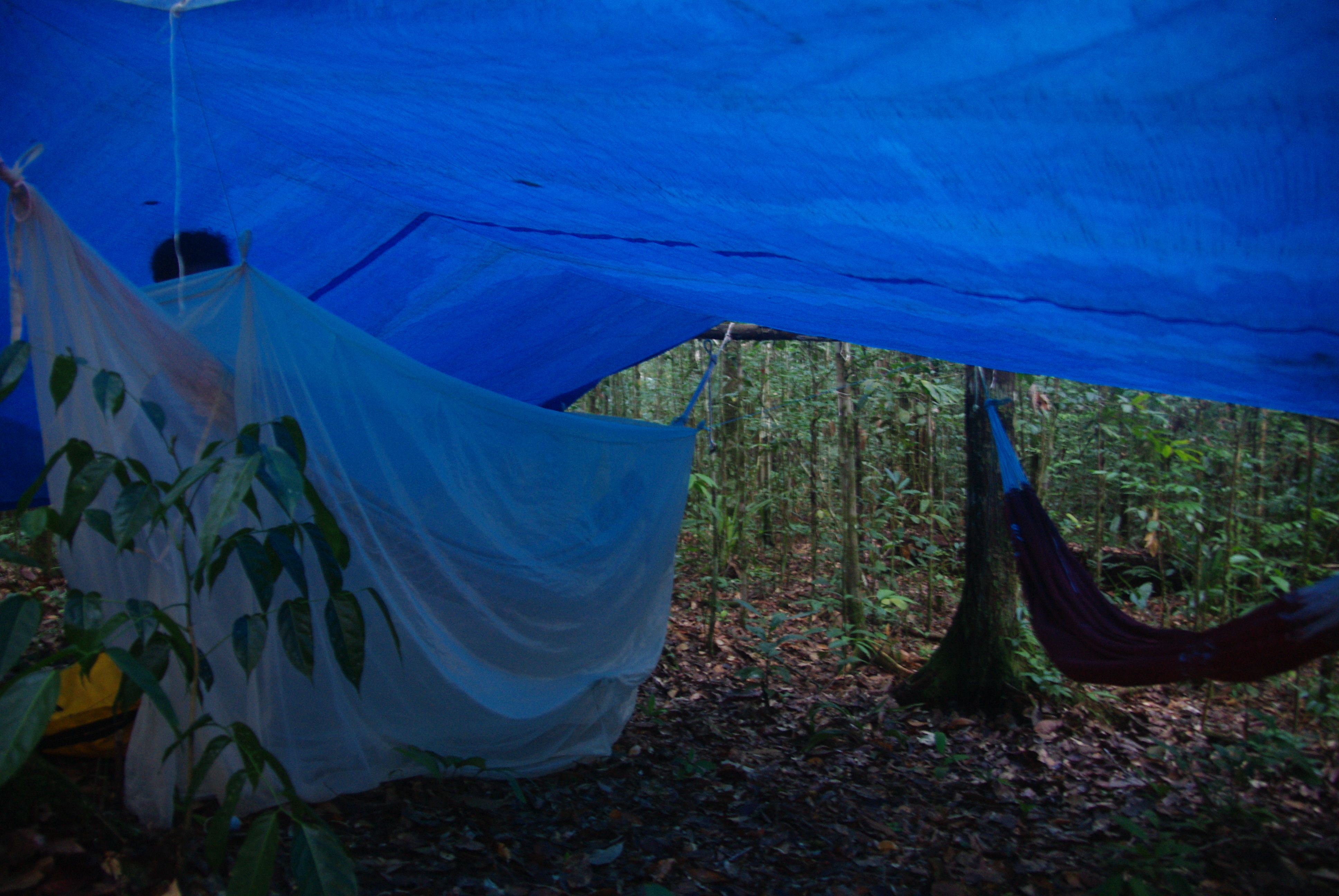
Once our accommodations for the night were set up, we went off on a night hike to explore a small cave. This cave featured a small waterfall that fell down through a hole in the ceiling, and the water had the effect of funneling any moonlight filtering down through the vegetation down into a tiny pool inside the cave; this created a beautiful, ghost-like effect on the waterfall. The pool was home to tiny albino catfish and shrimp, devoid of any color due to their existence in virtual permanent darkness. Rinaldo flashed his torch around the cave and discovered a rather large cayman crocodile nestled under the rocks. He recommended we make a fairly hasty exit, and so we did.
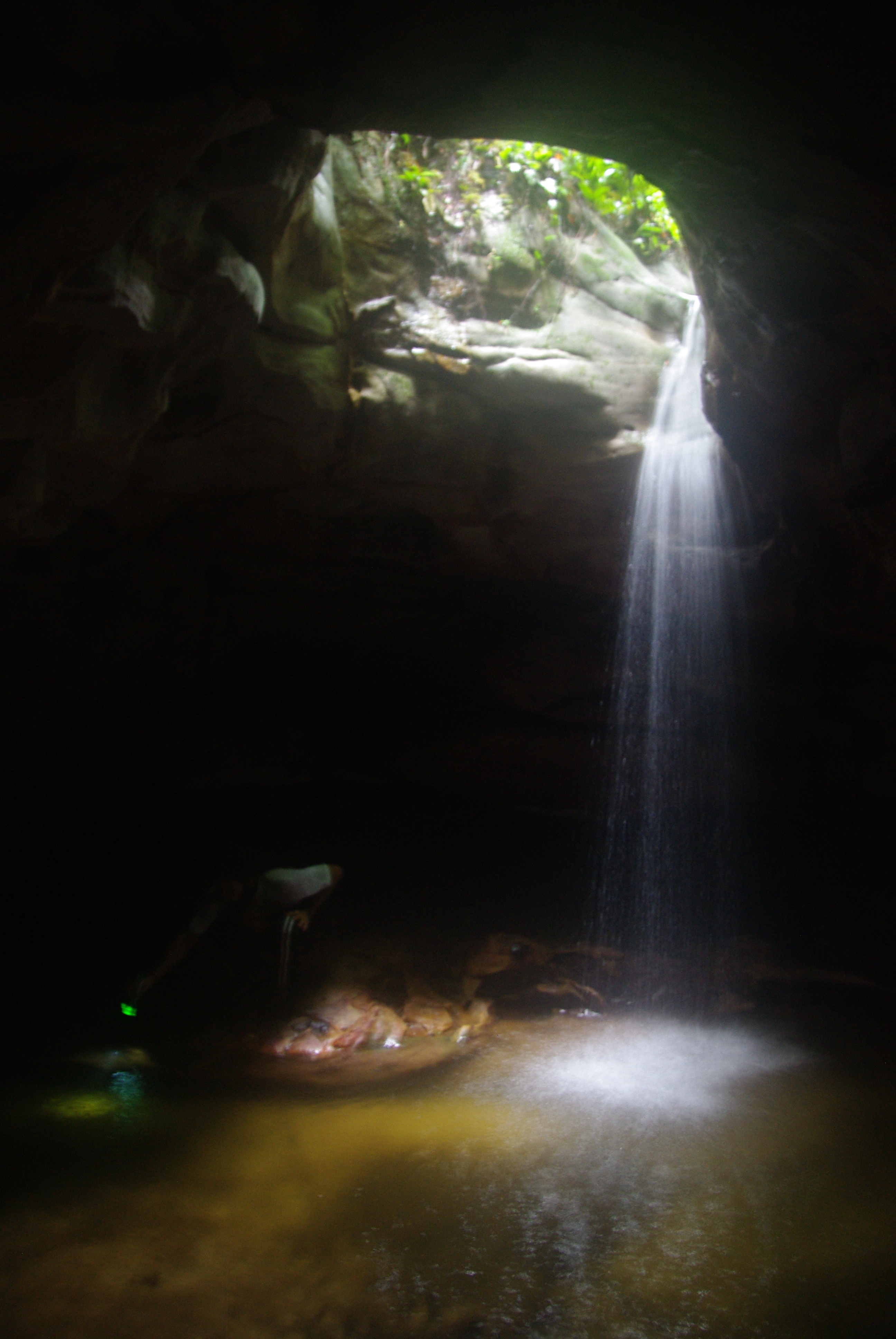
The next morning, pre-dawn, as a mist surrounded the entire forest, I was awakened by a distant bellowing sound from far up in the canopy. “Howler monkeys,” Rinaldo explained. I tried to look up, but in the semi-darkness, it was impossible to see them. I fell back asleep again; it had taken me half the night to fall asleep due to the oppressive heat and humidity so I was still tired. An hour or so later, I was startled awake by a searing pain on my arm. And then there was another. I looked down and found that half-inch long ants with giant mandibles had managed to get inside my netting. I must have picked a tree that housed one of their nests, and they were defending their turf fearlessly. I had about two dozen of them all over my body sinking their large pincer-like jaws into my skin to drive me away.
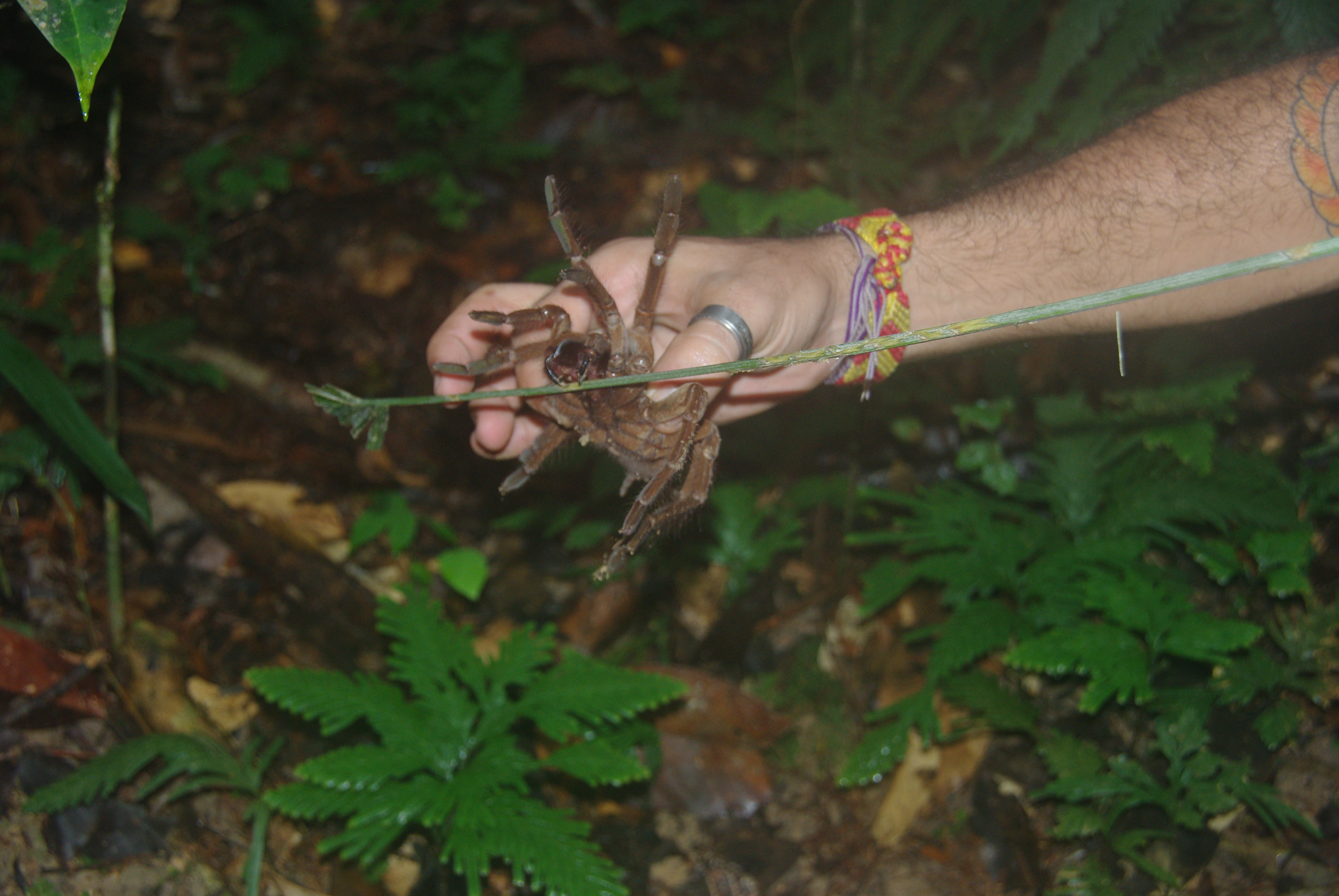
A post-breakfast hike led us to a spot where Rinaldo found a hole next to an old tree. He took a twig and poked around inside, and a few seconds later, out emerged a juvenile female bird-eating spider. It was the size of a human hand–how big is an adult then?! Rinaldo skillfully picked it up by its back. This gorgeous, but intimidating looking tarantula’s hairs were bristly and touching them left our skin irritated for an hour or more afterwards.
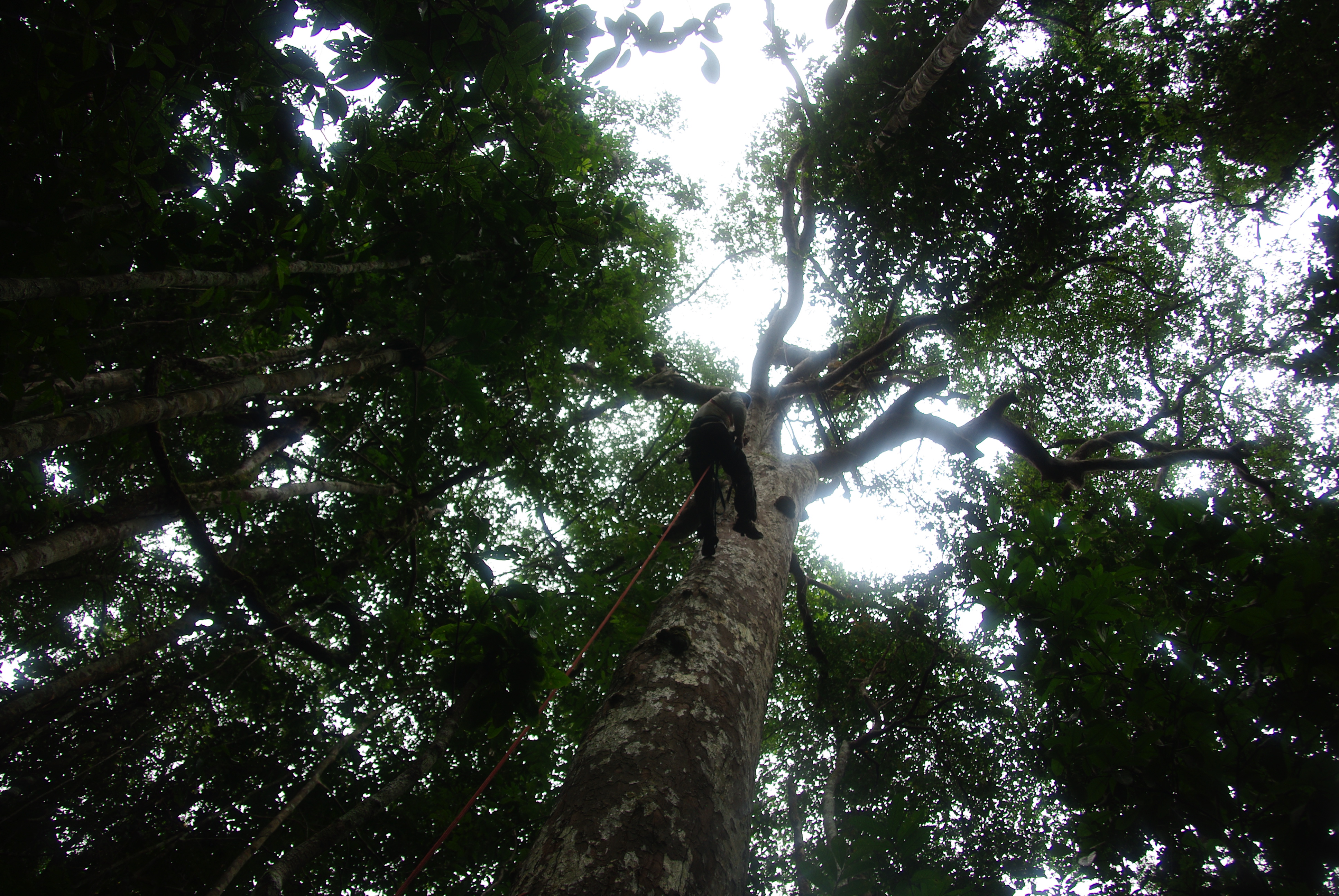
Early in the afternoon, the couple from Florida arrived, along with another guide who was tasked with setting up a tour of the canopy and a zip line across a thicket in the forest. At last, I would get to see something from the tops of the trees! We were to go one at a time, and the young man who had joined us went first. He went up the canopy and then transferred to the zip line. I was waiting below, helmet on and ready to go. Now keep in mind, this isn’t your Costa Rica ecotour zipline here across a wide open space. This was a freshly wired line in the middle of a dense jungle. The young man took off down the line and a few seconds later we heard a yell driven by fear and then a colossal “CRACK!” This was followed by shouts of “Oh my God!” in Portuguese from the zip line guide, and subsequent concerned yells from the girlfriend. We ran to go find the poor fellow who was dangling helplessly from the wire. He had hit a tree at full-speed, evidence of which was obvious in the freshly split tree trunk that thankfully had broken or else might have done even worse damage. We feared the worst at this point, but “fortunately” the principal point of contact was the biggest bone in the body–the thigh. His leg was turning purple and red and was swelling to twice the normal size, but thank goodness he hadn’t hit his head. He was unable to walk and we had to carry him out along the rough “trail” for a couple of hours to reach the river. He was still a two hour boat ride and three hour drive to the hospital at Manaus. Days later I heard he was okay but had broken bones in places and had to fly home to Florida for surgery. I can’t imagine what his girlfriend was going through at the time. Rinaldo, the cook (forgive me I have forgotten his name) and I were shaken. It was just the three of us once again.
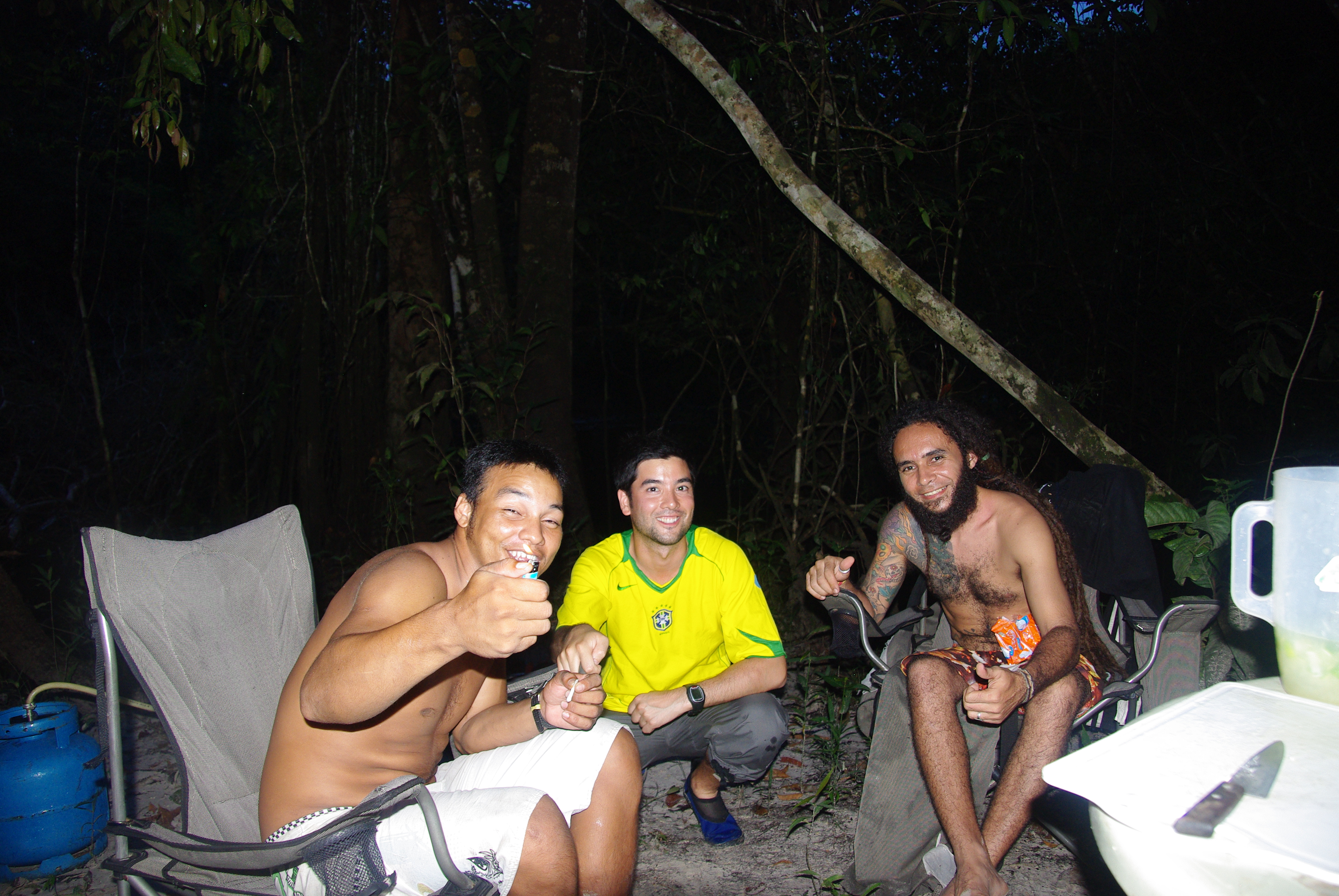
We could have gone home, but we decided to carry on. We packed up our gear, stowed it back in our kayaks, and paddled on in silence to our next destination. That night, we camped closer to the river, each of us lost in various thoughts about the day’s events, hoping our new friend would be alright. The tambaqui wasn’t so good that night (even though the cook was phenomenal making what he did with the limited equipment he had); the bottle of cachaca helped. We fell asleep in our hammocks and it was not too long after our campfire had died down when I heard a little crackling high above my head. And then, silence again. But then another crackle. And another, louder this time. And then it became all too clear what was happening, even to me: a tree was coming down. A great crashing noise ensued as the enormous tree brought down other trees with it on its descent. Not knowing what to do, I uttered a one word question, “Rinaldo!?” The reply that came back in the darkness had two words: “Just pray.” I closed my eyes, and the tree came down with a great splash in the river next to us. A wave swept up and washed over our gear, but we were unscathed. In the darkness, had we tried to flee, we could have blindly run into the path of the falling tree. Rinaldo was right, all we could do was hope and pray the tree would miss us. The next morning, we saw that this tree had come down about 25 meters from us. The wave had washed over our kayaks and scattered some of our equipment. We decided at that moment that had been our last night.
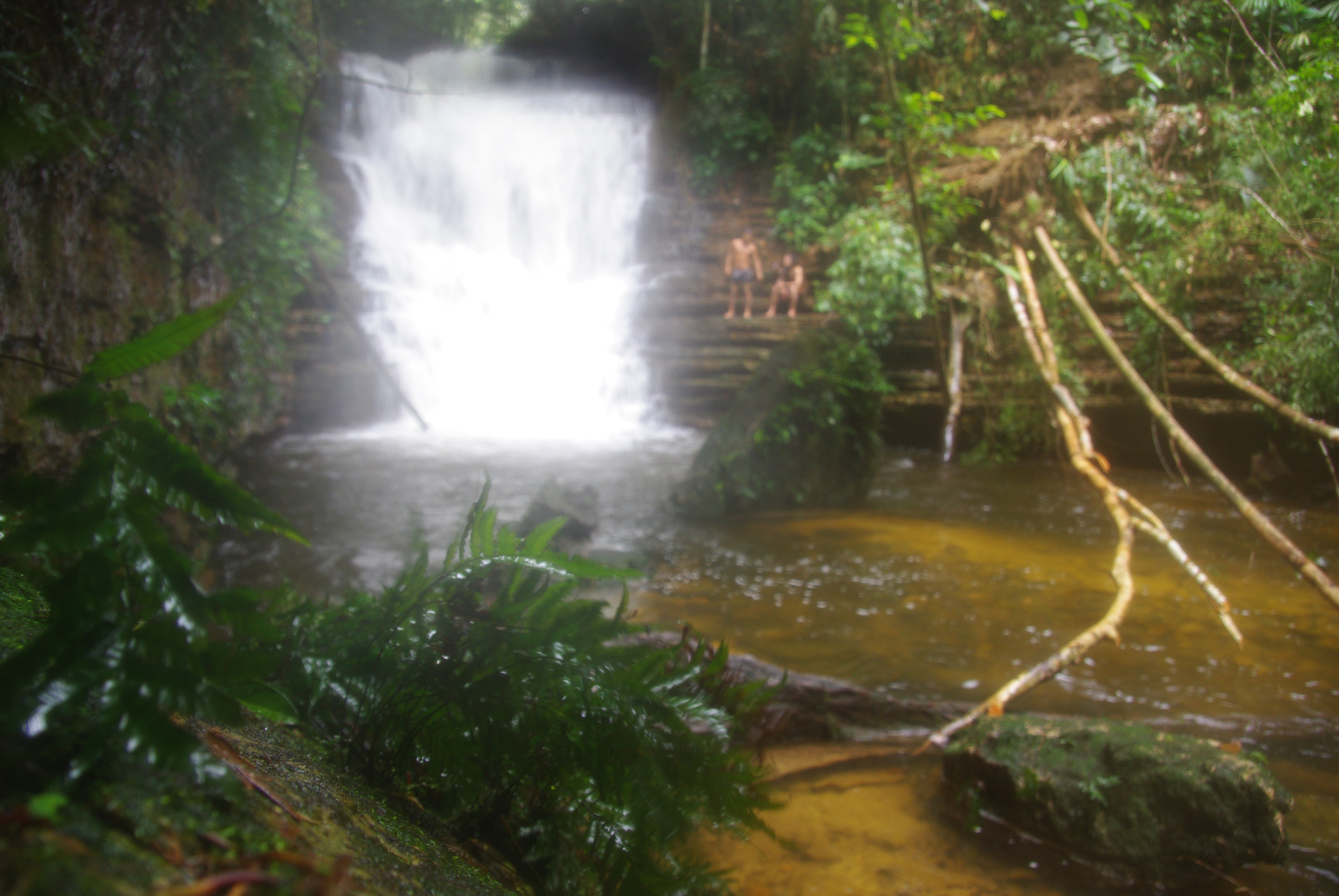
We went on one last hike that day, to go to a creek and see a waterfall. At this point, despite the dry bags, everything I had smelled like swamp. I was getting blisters in my shoes from the constant moisture inside my waterproof hiking boots. The heat and humidity never let up, and we’d come to a part of the river where the water didn’t have enough acidity anymore to keep the mosquitoes away. The creek and waterfall were a godsend. The cold water so refreshing. We used it as a shower. When I came back to put my rain gear back on (it was basically necessary all the time), my jacket was covered with a blanket of mosquitoes that had followed my trail of carbon dioxide and heat. That afternoon, we set back up the river in our kayaks, as beautiful hyacinth macaws flew overhead. Again, they were too high to make out any colors or features, except for the tell-tale silhouettes of their long tail feathers. I arrived back at my hotel in Manaus around 1130PM. Drained and exhausted. And I had a 4AM flight to wake up for the next morning.
It was perhaps the only time in my travels I was truly shaken. I wasn’t sure if I was just incredibly lucky to still be alive or if we had been simply very unlucky. I was completely reliant on Rinaldo out there, and thankfully he was a very good man despite his, and he won’t mind me saying it– gruff Rasta exterior. I see now from looking at their website that Amazon Mystery Tours no longer offers a zip line option, which was the right course of action for them to take. The staff I interacted with were very personable. If you have read this story and still want to venture into the Amazon jungle, they would be the ones to go with. If you have read this and said to yourself, “No thanks! Not for me!” May I suggest to you a visit to the Pantanal instead!
Please enjoy some more photos in the slideshow below.
Note: The photos in this post are “as they were.” It was so humid and moist in the rainforest that my lens fogged up every single time I took out my camera.
Thanks for reading this post! If you liked it please think about subscribing by following this link Subscribe here. You will receive an email when new articles are posted. Your email address will be secure and you will never receive any marketing emails from third parties. Every new subscriber matters since this is a relatively young site. We really appreciate your support.

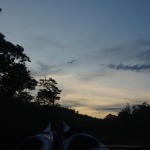
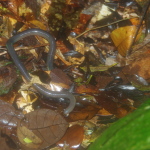
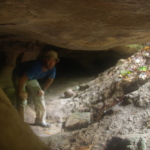
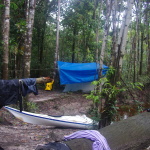
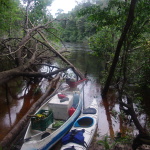
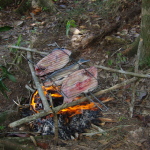
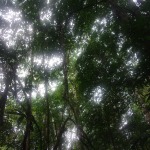
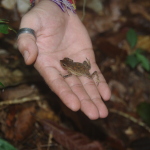
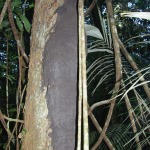
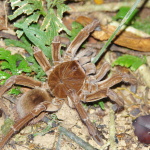
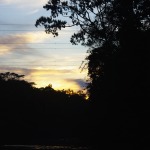
great writing, George! I remember you telling us this story.
I didn’t realize you were traveling around now. Looking forward to hearing more of these stories!
Thanks, Jess! I will be on the road more and more. Stop by any time. Always love hearing from you.